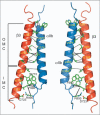Structural basis of transmembrane domain interactions in integrin signaling
- PMID: 20168080
- PMCID: PMC2900621
- DOI: 10.4161/cam.4.2.10592
Structural basis of transmembrane domain interactions in integrin signaling
Abstract
Cell surface receptors of the integrin family are pivotal to cell adhesion and migration. The activation state of heterodimeric alphabeta integrins is correlated to the association state of the single-pass alpha and beta transmembrane domains. The association of integrin alphaIIbbeta3 transmembrane domains, resulting in an inactive receptor, is characterized by the asymmetric arrangement of a straight (alphaIIb) and tilted (beta3) helix relative to the membrane in congruence to the dissociated structures. This allows for a continuous association interface centered on helix-helix glycine-packing and an unusual alphaIIb(GFF) structural motif that packs the conserved Phe-Phe residues against the beta3 transmembrane helix, enabling alphaIIb(D723)beta3(R995) electrostatic interactions. The transmembrane complex is further stabilized by the inactive ectodomain, thereby coupling its association state to the ectodomain conformation. In combination with recently determined structures of an inactive integrin ectodomain and an activating talin/beta complex that overlap with the alphabeta transmembrane complex, a comprehensive picture of integrin bi-directional transmembrane signaling has emerged.
Figures




References
-
- Hynes RO. Integrins: Bidirectional, allosteric signaling machines. Cell. 2002;110:673–687. - PubMed
-
- Ginsberg MH, Partridge A, Shattil SJ. Integrin regulation. Curr Opin Cell Biol. 2005;17:509–516. - PubMed
-
- Bennett JS, Berger BW, Billings PC. The structure and function of platelet integrins. J Thromb Haemost. 2009;7:200–205. - PubMed
Publication types
MeSH terms
Substances
Grants and funding
LinkOut - more resources
Full Text Sources
